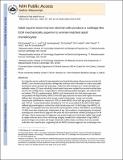| dc.contributor.author | Kisiday, John D. | |
| dc.contributor.author | Frisbie, David D. | |
| dc.contributor.author | Plaas, A. H. K. | |
| dc.contributor.author | Kopesky, Paul Wayne | |
| dc.contributor.author | Leeb, Steven B. | |
| dc.contributor.author | Vanderploeg, Eric J. | |
| dc.contributor.author | Ortiz, Christine | |
| dc.contributor.author | Grodzinsky, Alan J. | |
| dc.date.accessioned | 2011-10-26T17:34:59Z | |
| dc.date.available | 2011-10-26T17:34:59Z | |
| dc.date.issued | 2010-02 | |
| dc.date.submitted | 2010-02 | |
| dc.identifier.issn | 0945-053X | |
| dc.identifier.uri | http://hdl.handle.net/1721.1/66584 | |
| dc.description.abstract | Our objective was to evaluate the age-dependent mechanical phenotype of bone marrow stromal cell- (BMSC-) and chondrocyte-produced cartilage-like neo-tissue and to elucidate the matrix-associated mechanisms which generate this phenotype. Cells from both immature (2–4 month-old foals) and skeletally-mature (2–5 year-old adults) mixed-breed horses were isolated from animal-matched bone marrow and cartilage tissue, encapsulated in self-assembling-peptide hydrogels, and cultured with and without TGF-β1 supplementation. BMSCs and chondrocytes from both donor ages were encapsulated with high viability. BMSCs from both ages produced neo-tissue with higher mechanical stiffness than that produced by either young or adult chondrocytes. Young, but not adult, chondrocytes proliferated in response to TGF-β1 while BMSCs from both age groups proliferated with TGF-β1. Young chondrocytes stimulated by TGF-β1 accumulated ECM with 10-fold higher sulfated-glycosaminoglycan content than adult chondrocytes and 2–3-fold higher than BMSCs of either age. The opposite trend was observed for hydroxyproline content, with BMSCs accumulating 2–3-fold more than chondrocytes, independent of age. Size-exclusion chromatography of extracted proteoglycans showed that an aggrecan-like peak was the predominant sulfated proteoglycan for all cell types. Direct measurement of aggrecan core protein length and chondroitin sulfate chain length by single molecule atomic force microscopy imaging revealed that, independent of age, BMSCs produced longer core protein and longer chondroitin sulfate chains, and fewer short core protein molecules than chondrocytes, suggesting that the BMSC-produced aggrecan has a phenotype more characteristic of young tissue than chondrocyte-produced aggrecan. Aggrecan ultrastructure, ECM composition, and cellular proliferation combine to suggest a mechanism by which BMSCs produce a superior cartilage-like neo-tissue than either young or adult chondrocytes. | en_US |
| dc.description.sponsorship | National Institutes of Health (U.S.) (EB003805) | en_US |
| dc.description.sponsorship | National Institutes of Health (U.S.) (AR33236) | en_US |
| dc.description.sponsorship | National Science Foundation (U.S.) (NSF-NIRT 0403903) | en_US |
| dc.description.sponsorship | National Institutes of Health (U.S.). Molecular, Cell, and Tissue Biomechanics Training Grant Fellowship | en_US |
| dc.description.sponsorship | Arthritis Foundation | en_US |
| dc.language.iso | en_US | |
| dc.publisher | Elsevier Ltd. | en_US |
| dc.relation.isversionof | http://dx.doi.org/10.1016/j.matbio.2010.02.003 | en_US |
| dc.rights | Creative Commons Attribution-Noncommercial-Share Alike 3.0 | en_US |
| dc.rights.uri | http://creativecommons.org/licenses/by-nc-sa/3.0/ | en_US |
| dc.source | PubMed Central | en_US |
| dc.title | Adult equine bone-marrow stromal cells produce a cartilage-like ECM superior to animal-matched adult chondrocytes | en_US |
| dc.type | Article | en_US |
| dc.identifier.citation | Kopesky, P.W. et al. “Adult equine bone marrow stromal cells produce a cartilage-like ECM mechanically superior to animal-matched adult chondrocytes.” Matrix Biology 29 (2010): 427-438. Web. 26 Oct. 2011. © 2010 Elsevier Inc. | en_US |
| dc.contributor.department | Massachusetts Institute of Technology. Center for Biomedical Engineering | en_US |
| dc.contributor.department | Massachusetts Institute of Technology. Department of Biological Engineering | en_US |
| dc.contributor.department | Massachusetts Institute of Technology. Department of Electrical Engineering and Computer Science | en_US |
| dc.contributor.department | Massachusetts Institute of Technology. Department of Materials Science and Engineering | en_US |
| dc.contributor.approver | Grodzinsky, Alan J. | |
| dc.contributor.mitauthor | Kopesky, Paul Wayne | |
| dc.contributor.mitauthor | Leeb, Steven B. | |
| dc.contributor.mitauthor | Vanderploeg, Eric J. | |
| dc.contributor.mitauthor | Ortiz, Christine | |
| dc.contributor.mitauthor | Grodzinsky, Alan J. | |
| dc.contributor.mitauthor | Kisiday, John D. | |
| dc.relation.journal | Matrix Biology | en_US |
| dc.eprint.version | Author's final manuscript | en_US |
| dc.type.uri | http://purl.org/eprint/type/JournalArticle | en_US |
| eprint.status | http://purl.org/eprint/status/PeerReviewed | en_US |
| dspace.orderedauthors | Kopesky, P.W.; Lee, H.-Y.; Vanderploeg, E.J.; Kisiday, J.D.; Frisbie, D.D.; Plaas, A.H.K.; Ortiz, C.; Grodzinsky, A.J. | en |
| dc.identifier.orcid | https://orcid.org/0000-0003-3511-5679 | |
| dc.identifier.orcid | https://orcid.org/0000-0002-3856-6005 | |
| dc.identifier.orcid | https://orcid.org/0000-0003-0026-6215 | |
| dc.identifier.orcid | https://orcid.org/0000-0002-4942-3456 | |
| mit.license | OPEN_ACCESS_POLICY | en_US |
| mit.metadata.status | Complete | |
